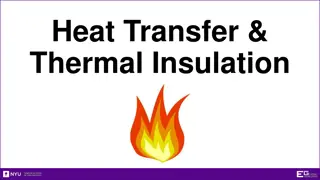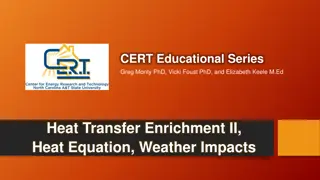Understanding Temperature, Heat, and Energy Transfer
Explore the concepts of temperature scales, absolute zero, heat transfer, units of heat, equivalence between heat and energy, specific heat capacity, and more. Learn about the relationship between heat, energy, and temperature in an engaging visual format.
Download Presentation

Please find below an Image/Link to download the presentation.
The content on the website is provided AS IS for your information and personal use only. It may not be sold, licensed, or shared on other websites without obtaining consent from the author. Download presentation by click this link. If you encounter any issues during the download, it is possible that the publisher has removed the file from their server.
E N D
Presentation Transcript
Chapter 17 TEMPERATURE AND HEAT
HEAT Heat is the amount energy transfer due to a temperature difference. All other forms of energy transfer are classified as work. In the picture below, heat is flowing from the hot object to the cold object.
UNIT OF HEAT People used to think that heat was not the same as energy. Therefore they invented a separate unit for heat, the calorie. Terminology: cal: little cal Cal: big cal (this is the unit found on food labels)
ARE YOU ON DIET? Energy Density Food Component Cal/g Fat 9 Ethanol (Alcohol) 7 Proteins 4 Carbohydrates 4
THE EQUIVALENCE BETWEEN HEAT AND ENERGY Joule proved that heat is equivalent to energy by the following experiment: He proved that one can raise the temperature of water by doing mechanical work (which involves no temperature difference or heating). He found it took 4.186J of energy to raise the temperature of 1g of water by 1 C, hence 1cal=4.186J.
T IN K AND IN C Although TK and TC differs by 273 (recall: TK = TC +273), when it comes to T the two scales are the same. That is why in c, it does not matter whether you write 1J kg-1 K-1or 1J kg-1 C-1 . Tf Ti 1 C 0 C 20 C 10 C 100 C 0 C T 1 C 10 C 100 C Tf Ti T 1K 10K 100K 274K 293K 372K 273K 283K 273K
MORE ON THE UNITS Make sure you know how to convert among the following units: Specific heat capacity is the amount of heat required to raise the temperature of 1kg of a substance by 1K.
EXAMPLE A 80kg man has a fever of 39 C. How much heat is required to raise his temperature by that amount? [Normal temperature: 37 C, c =4190Jkg-1K-1]
MOLAR HEAT CAPACITY First a reminder about moles: Define the molar mass M as the mass of one mole of substance, then n moles of the substances would have the mass of:
CHANGE OF PHASE AND LATENT HEAT There is no T in the above equation, because there is no temperature change during phase change. Latent heat of fusion: Energy required to melt 1kg of solid Latent heat of vaporization: Energy required to vaporize 1kg of liquid Latent heat of fusion Latent heat of vaporization Solid +
NO CHANGE IN TEMPERATURE Heat is absorbed during a phase change but the temperature does not change.
WATER: SPECIFIC HEAT CAPACITIES AND LATENT HEATS To warm ice (specific heat of ice) 2.10kJkg-1K-1 To melt ice (latent heat of fusion) 334kJkg-1 To warm water (specific heat of water) 4.19kJkg-1K-1 To vaporize water (latent heat of vaporization) 2260kJkg-1 To warm steam (specific heat of steam) 2.02kJkg-1K-1
EXAMPLE Find the total amount of energy required to heat 3g of water from - 15 C to 155 C. To warm ice 3g 2.10kJkg-1K-1 15K 94.5J To melt ice 3g 334kJkg-1 1002J To warm water 3g 4.19kJkg-1K-1 100K 1257J To vaporize water 3g 2260kJkg-1 6780J To warm steam 3g 2.02kJkg-1K-1 55K 333.3J Total 9470J
SODA IN AN ICE BOX Which will do a better job cooling your soda, a cooler filled with water at 0 C, or a cooler filled with ice at 0 C? A. Water B. Ice C. The same
HEAT TRANSFER When two objects are in thermal contact, the heat lost by one is the heat gain by the other by conservation of energy. For example, if QH =-150J, then QC =+150J. In general, we have: If one of the Q is positive, the other must be negative.
HEAT TRANSFER FOR MORE OBJECTS When there are more than two objects present, then the conservation law earlier generalizes to:
EXAMPLE 2kg of water at 300K is mixed with 2kg of water at 350K. Find the final temperature.
EXAMPLE 1.5kg of X at temperature 400K is dropped into 3kg of water at 300K. The final temperature is 360K. Find the specific heat capacity of X.
A student wants to cool 0.25kg of soda, initially at 25C, by adding ice initially at -20 C. How much ice should be she add so that the final temperature is 0 C with all the ice melted?























